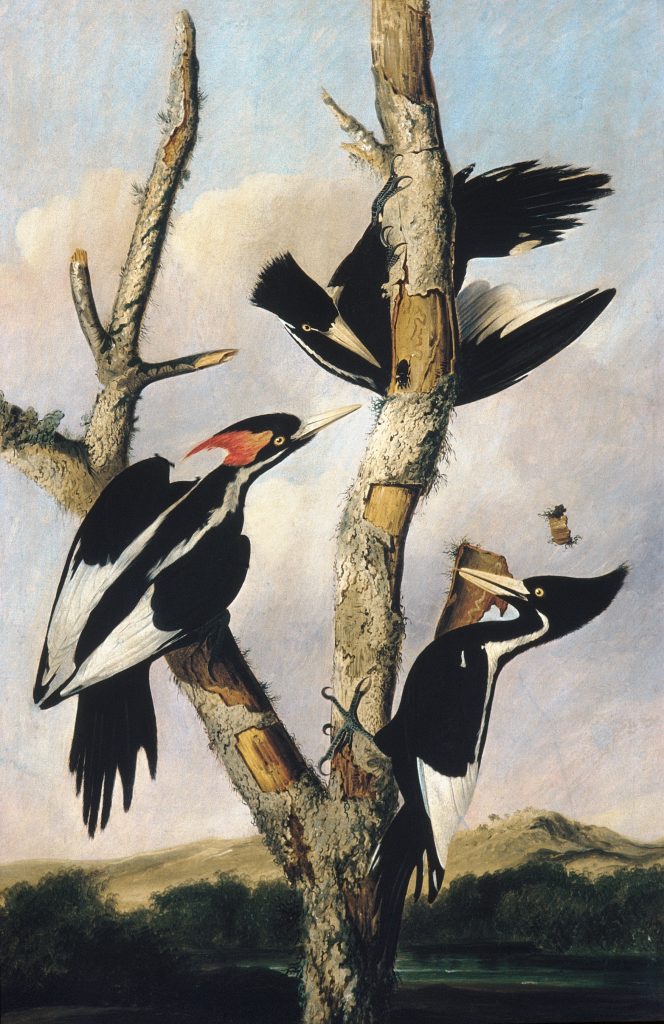We saw her for the last time in 1944—frantic, wild-eyed, twitching about in her tree. Or rather, 23-year-old wildlife artist Don Eckelberry saw her, having traveled south to Louisiana’s Singer Tract to sketch America’s last Ivory-billed Woodpecker.*
It was a less than ideal situation. After all, National Audubon Society president John Baker would have much preferred to have found a way to save the bird rather than dispatch a man to sketch her. However, after negotiations with the Chicago Lumber Company broke down (“We are just money grubbers,” the company’s chairman allegedly said), Baker wasn’t left with much of a choice. Since the land couldn’t be spared (and by extension, the bird), Baker sent Eckelberry south in the hopes the artist might preserve her image.
The woodpecker (known also as the “Lord God Bird” for the phrase most often uttered upon seeing one) was paying a high price for man’s destruction. For decades we’d halved their habitat, felling the cypress trees to smithereens, the hollers of “Timber, timber, timber, timber” droning out their kent-calls. And then one day “those” birds became “that” bird, and that bird became the only one left to sketch. The black-crested female made herself available to the man with the sketchbook: posed, pecked, trumpeting her fading call.
Frantic and wild-eyed himself, Eckelberry saved what part of her he could. For two weeks he tracked her, writing and sketching every last detail he could. Eckelberry went where she went—taking a boat upriver past Alligator Bayou, then a car to John’s Bayou, and finally, began loitering around the roost tree, his ear cocked and awaiting the sound of her call. At around 6:30 PM, as the barred owls hooted in anticipation of their evening hunt, their calls were interrupted by another sound. Eckelberry and his guide froze, awaiting confirmation of what they thought they heard. And suddenly, there it was: an unmistakable note, followed by a rap, echoing through the trees.
For thirteen minutes the men heard her, anxiously awaiting her grand entrance. Finally, amid the Downies and the Red-bellieds came the long-awaited woodpecker, her wings, according to Eckelberry, “cleaving the air in strong, direct flight” as she “alighted with one magnificent upward swoop.” But in a less heroic description he also made note of her “hysterical pale eyes” and “frantic aliveness”—descriptions he tried to capture in his sketches.
Seventy years later and a thousand miles away, while perusing a manila folder in Wausau, Wisconsin’s Leigh Yawkey Woodson Art Museum, I find what remains of those sketches. I’d traveled to the museum for the extinct bird exhibition; anxious to see paintings of Passenger Pigeons and Great Auks and representations of all the birds we’ll never see again. But I’d never expected to find Eckelberry’s last sketches of America’s last Ivory-bill, at least not until the curator offhandedly mentioned to me that she had them in her office.
The curator and I wound through the museum’s stairwells and corridors until arriving there. As I opened the folder and held the sketches in my hands, I could feel a bit of both artist and subject alongside me. What must’ve it been like to watch a species disappear before his eyes? And what must’ve it been like to be the last of her kind, offering her call only to hear the echo call back?
As I stare at Eckelberry’s sketches, my waxing poetic turns suddenly practical. I notice that in half of the sketches, including the portrait, the female’s black crest is sketched red—the clear marking of a male. Which means nothing on its own; merely that Eckelberry was, perhaps, taking a bit of creative license to offer posterity a depiction of both.

Unless, I think, it means everything.
My conspiracy theory goes a little like this: Well aware of the attention he’d draw by acknowledging the existence of a breeding pair, Eckelberry remained mum, instead reporting only the female, thereby protecting the privacy of the world’s last chance for an egg. And maybe, deep in the hole in the roosting tree there was an egg, or two eggs, or enough eggs to keep our Lord God Bird alive awhile longer. Perhaps he kept his truth hidden in his sketches, until a decade or so after his death, when some poor fool who wanted too much to believe in the bird’s resurrection suddenly found a new reason to do so.
Of course! I think, staring at the red crest aflame in the sketches stretched before me. But of course not, also. What I need is some long, lost letter to confirm it, though when no such letter makes itself available, I make do with an unpublished Eckelberry poem, instead.
Another clue, I think, reaching toward the carefully typed script. In his untitled poem, Eckelberry wrote: “Mostly we are preserved / in life beyond our time / Glazed, pickled, set in amber / and casketed above the ground.”
… casketed above the ground …
In silence, I return the poem to its place inside the folder.
What if, I think, her echo wasn’t an echo after all, but a ‘Hello, sweetheart, welcome home’?
*
This excerpt—in slightly different form—is forthcoming on Wisconsin Life and in Flock Together: A Love Affair With Extinct Birds.
*Author’s Note: In 2004-2005, the Ivory-billed Woodpecker was believed to have been seen again. Yet after years of extensive searching yielded no confirmed sightings, Eckelberry’s 1944 sighting remains—according to most—the last undisputed, confirmed sighting.
Image: Kidd, Joseph Bartholomew. “Ivory-billed Woodpecker.” 1830–31. Oil on canvas. The Metropolitan Museum of Art, New York.




